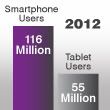Mobile Dating
Steers Publishers & App Developers To Monetization
By Amy Vale
 Finding love and romance isn’t always easy, especially in
a world where people live on-the-go and are always rushing to the next activity
with multiple devices in their hands. It’s this very rushed style of dating
that’s driven the huge surge in popularity of online dating sites. And that
popularity is moving to the small screen too, as mobile dating is on pace to
overtake online dating as the preferred channel for finding love around the
world. Statistics now say that 80%
of single people prefer mobile dating apps over online dating sites. If
that isn’t proof enough, a Snap
Interactive survey of 50,000 people found that four out of five single
people prefer using Smartphones to get dates, compared to online dating sites. With
the number of mobile users worldwide rising at a pace faster than we could
imagine, how can publishers and app developers monetize the high traffic of
mobile users searching for love on-the-go?
Finding love and romance isn’t always easy, especially in
a world where people live on-the-go and are always rushing to the next activity
with multiple devices in their hands. It’s this very rushed style of dating
that’s driven the huge surge in popularity of online dating sites. And that
popularity is moving to the small screen too, as mobile dating is on pace to
overtake online dating as the preferred channel for finding love around the
world. Statistics now say that 80%
of single people prefer mobile dating apps over online dating sites. If
that isn’t proof enough, a Snap
Interactive survey of 50,000 people found that four out of five single
people prefer using Smartphones to get dates, compared to online dating sites. With
the number of mobile users worldwide rising at a pace faster than we could
imagine, how can publishers and app developers monetize the high traffic of
mobile users searching for love on-the-go?
According to a New
York Times article, mobile dating apps are fast becoming the favored method
of finding love due in large part to the ease of use and immediacy offered by
location-based targeting capabilities. Essentially, users can flirt and set up
dates at a much faster rate on their mobile devices. With the added benefit of
“instant dating,” these app users can find someone with similar interests who
is nearby instantly. So how can publishers and app developers prevent their
dating apps and mobile sites from becoming a one-hit wonder and generate
consistent streams of revenue from them?
Since a growing number of mobile dating sites and apps
leverage location-based features, using geo-location targeting in the mobile
ads and in-app ads has tremendous value because they fill the instant and local
needs of mobile daters. In late 2011, the hugely popular online dating site
OKCupid delved into the mobile world with its ‘OKCupid Locals’ app. The dating
site’s bid to monetize with mobile is a very smart move, and exactly the type
of mobile move analyst
Mary Meeker would approve of. OKCupid Locals has found that a tenth of its
2.5 million active members use the location features within the mobile app.
Given these high numbers, location-based targeting will make mobile ads a
lucrative business for publishers and app developers. Imagine a
thirty-something female professional sitting at a local coffee shop on a
Saturday afternoon, idly browsing through the OKCupid Locals app on her
Smartphone. Geo-location targeting ensures that the mobile ads served within
the app on her Smartphone are geographically relevant to her. When it comes to
dating, the more relevant and targeted these ads are (whether on a mobile-optimized
dating site or app), the greater the likelihood of converting mobile site
visits into a consistent source of revenue.
Another way to monetize these dating apps and make them
stand out from the pack is the Freemium model, whereby it’s free to download an
app initially and a healthy portion of revenue comes from in-app purchases. According
to IHS
iSuppli’s market intelligence, revenue from in-app purchases is expected to
increase to $5.6 billion in 2015, up from $970 million in 2011, and will
account for 64% of total market revenue. To make the case for in-app purchases
in the world of love and flirting, let’s look at one app that’s monetizing a
bit differently from other socially-driven apps like Instagram, Pinterest and
Tumblr. Skout
boasts some pretty serious engagement numbers asthe dating app supports 300
million messages a month, its average
user checks in about 8 to 9 times a day and it’s signing up about one million
users each month. Instead of using mobile ads, Skout’s mobile revenue stream
comes in large part from in-app purchases. Essentially, Skout app users can
purchase “points” which can be used in a number of ways, including sending
virtual gifts, seeing who is viewing their profile and sending “wink bombs.”
Clearly, mobile dating is gaining favor with consumers
around the world. And the benefits of finding instant, local love on the small
screen aren’t only confined to daters; there’s plenty of revenue to be made
long-term following the route of in-app ads and in-app purchases.



